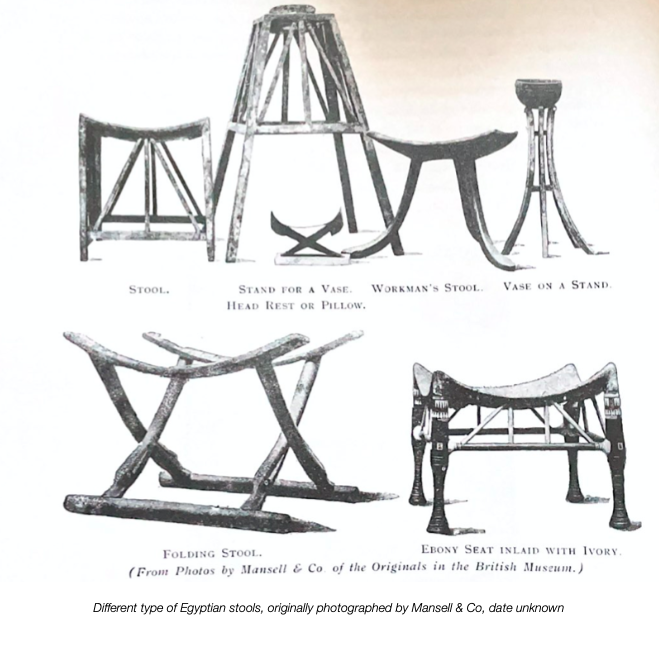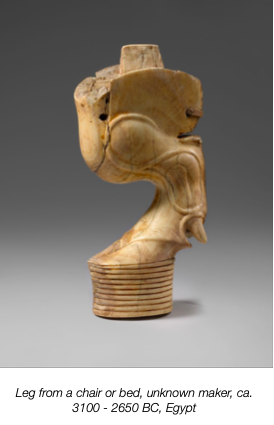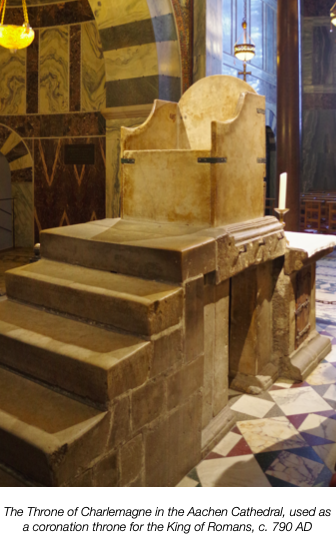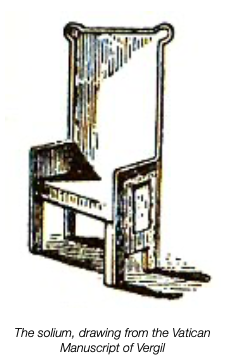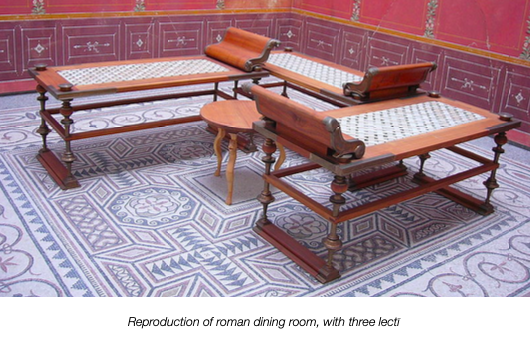History of Upholstery ANCIENT TIMES
EGYPTIAN | GREEK | ROMAN
EGYPTIAN
Ancient Egyptian burial culture centred around the principle that each living soul had a double (named a Ka), which lived on during death provided the physical body was preserved with familiar surroundings.
Therefore furniture within tombs became more present during the Early Dynastic Period (3050-2686 BCE) and towards the beginning of the New Kingdom (1550-1069 BCE). Hand woodworking tools such as copper saws and copper awls became available by the beginning of the Early Dynastic period.
Craftsmen of this time were incredibly skilled and understood the importance of material in such dry climates. With little moisture in the air, wood could easily become brittle and split. Wood was in short supply as few native varieties of trees produced usable wood. The wood mostly used for fine carpentry was Cedar, imported from Lebanon and Syria. This made furniture expensive, being reserved for the elite wealthy, most people used mats for sitting. Ornamentation was preferred.
Stools became increasingly popular until around 2210 BCE when chairs, ie stools with backs and, introduced in the Old Kingdom, arms, took over. Stools were often shorter than that of today, reflecting both the shorted
The Middle Kingdom (2040-1782 BCE) saw the introduction of the folding stool and carved heads. The stools were made using an X shaped construction with a metal bolt. They tended to have animal skins attached to the seat rails, but in place of this, wood was sometimes painted to replicate.
The function of these stools grew in variety. Stools could be used for milking or lower stools with thick wool cushions could be made for old people. Chairs with backs were only made more accessible in 1930 BCE, but it wasn’t until the New Kingdom that the wealthy middle class became chair owners. The backs were separated from the legs, suggesting these chairs were simple extensions of the original stools.
Make it stand out
Lions heads were frequently carved over the front legs to emulate the idea that the owner was sitting on the back of a lion. Legs could often be carved to replicate the front and hind legs of bulls, lions or less frequently gazelles, but it was not uncommon to be left plain too.
Animal motifs are thought to have been used because of the concept of animal transformation in the afterlife, whereby the dead could metamorphose into animals.
GREEK
Evidence of the earliest Greek furniture can be found from 3000 BCE in statues from the Cyclades Islands, but its only during the Mycenaean period (ca. 1600 - 1100 BCE) that documentation began through ceramics, including miniature imitations of chairs made from terracotta, usually shown to enthrone goddesses. These miniature thrones sometimes had solid backs, sometimes latticework backs and usually 3 legs. Descriptions of chairs mention chairs made of ebony, inlaid with gold, ivory or tin. The timeline of Grecian furniture then became scare until 700-600 BCE, where furniture reappeared in sculpture and paintings. From his point Egyptian as well as Near Eastern influence is evident, with highly sophisticated designs of X shaped stools. Unlike Egyptian furniture however, Greek design was intended for everyone, not just the mega wealthy and thus it took a much simpler form.
KILSMOS CHAIR
The main types of furniture found in households were a four legged backless, foldable stool (named a diphros), considered the least important of the seats, used by both the elite and lowly; A daybed referred to as a kline, serving as both a bed and reclining seat during meals; the throne (thronos) usually with back and armrests, intended for gods, martyred heroes and VIPs; and a curved back chair called a klismos.
DIPHROS OKLADIAS STOOL
Despite its lack of nobility the diphros was varied in purpose and decor, much like Egyptian stools. Sometimes they included leather or boxlike seats and some had 3 or 4 legs. Older models had animal feet or hoofs, more modern versions were plainer and straighter. The diphros okladias became particularly favoured due to its ease of movement.
Within the 18th century upholstery rapidly advanced. This began with front lipped upholstery. Upholsterers began to encase hair inside a linen, cylindrical dome on the front edge of the frame, creating a lip. The back part of the seat would then be stuffed as normal. This allowed the shape of the seat to be maintained for longer. Next lipped upholstery was introduced, whereby the dome was not just on the front side of the chair, but diverged around the sides too. Seats became deeper and more rigid, but as rounded upholstery became less fashionable, square edged upholstery began to be sought after.
Thrones tended to be located within temples or the homes of the rich. There were four types, divided by the type of leg or foot detailing. Animal-pawed-feet thrones were shaped by Egyptian design and highly popular between 600-550 BCE. Thrones with turned legs can be traced back to the Minoan period (3000 - 1100 BCE). From 650 BCE thrones with rectangular legs were introduced. These thrones could be ornately decorated with scenes from greek mythology and became popular around the Roman period.
The klimos chair is considered one of the most sophisticated chairs ever created. Thought of as a stripped-down throne, sitters of the klismos included goddesses such as Athena as well as women generally, often depicted braiding their hair. The form of the chair displays the skill of the craftsmen that made it; the curved shape of the back and gently splayed legs suggest it was bent using steam.
The seat would be secured with tenons or dowels. Materials used to make the chairs were largely wood such as olive (native to Greece) cedar and yew (imported from Syria), boxwood, citrus wood, ebony as well as bronze. Although originally designed with elegance through simplicity, some klismos chairs can be seen with decoration to the legs such as rosettes and volutes. The front apron of the chair could also be decorated with mythical scenes.
The kline was typically made of olive wood but could also be made of bronze and iron. The form is suggested to an elongated throne, shaped by Egyptian design. These couches were covered with leather straps that would hold covers made from fleece or other skins and vibrant pillows to provide comfort.
ROMAN
Roman design followed on from the Greeks with focus on comfort and simplicity. Romans who could used furniture as an elaborate exhibition of wealth. Within the Roman period, there was development in the interior structure of the home. Rooms were created for different purposes and houses became much larger for a smaller number of people. Much of Roman furniture was made of wood, which does not preserve well, thus more metal and stone furniture has survived.
Make it stand out
Imported beech and willow were used for chair frames but other items of furniture were made from the particularly treasured citrus and maple; metals used included bronze, copper and iron; stones used included marble and limestone.
Many design elements were ruled by Greek influence, particularly after Greece came under Roman control in 146 BCE. This can be seen within the various different examples of stools created by the Romans. Most notably, the sella curulis or the curule, an interpretation of the X shaped Greek diphros. This was widely used by both members of seniority and the average person. Another example of Greek impact on design can be seen in the Roman throne, referred to as solium. The solium was identified by its elongated back but could be defined further through its other features.
Soliums with solid sides were reserved for official occasions, becoming fashionable during Imperial Rome (31 - 476 BCE). The second type of solium had turned or rectangular legs and was distinctly found in paintings from Pompeii. This type would prove highly influential on designers in the 13th and 14th centuries.
Couches with footboards and headrests could be used during banquets. Those without could be used as a daybed. Upholstery was not used by the Romans, so couches were made comfortable with wool or linen cushions laid over the frame. Decorative elements included turned legs, inlay, paintings or mounted metal.
The lectus was a descendant of the Greek kline, though far more popular in Roman society. These couches were intended to be used in threes, set up perpendicular to one another.
At the fall of the Roman empire (5 AD) there was a severe breakdown of trade. This was due to several factors, most prominently the fact that the empire was divided into smaller divisions and Roman roads were unmaintained. This increased difficulty in trading meant quality of goods suffered. Equally, drastic economic collapse meant luxuries such as furniture seemed somewhat unimportant. As the Romans left Britain, so did their way of life. It would be many centuries until western Europe would see such high standards in design.
BY LIBBY PAYNE
UPHOLSTERER @ LAWSON WOOD

